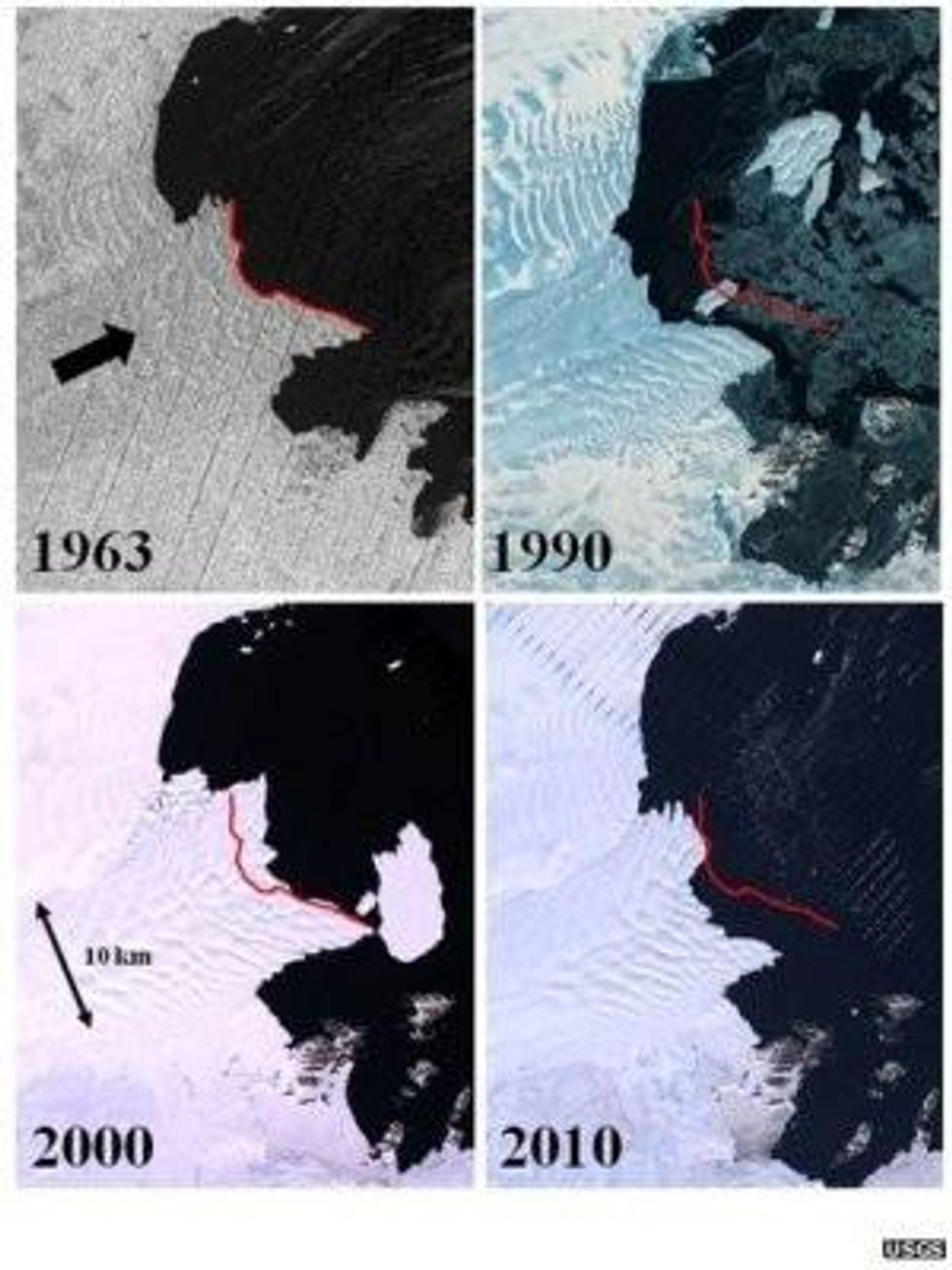

SUBSCRIBE TO OUR FREE NEWSLETTER
Daily news & progressive opinion—funded by the people, not the corporations—delivered straight to your inbox.
5
#000000
#FFFFFF
To donate by check, phone, or other method, see our More Ways to Give page.


Daily news & progressive opinion—funded by the people, not the corporations—delivered straight to your inbox.
A new study reveals that the world's largest ice sheet, previously thought to be at little risk from climate change, has undergone rapid changes in the past five decades, signaling a potential threat to global sea levels.

Using declassified spy satellite data from 1963 to 2012, researchers from the University of Durham looked at 175 glaciers along the ocean margins of the ice sheet and found "widespread and synchronous changes" consistent with climate change.
"We've shown for the first time that these glaciers are in concert with climate," Chris Stokes, a professor of geography at Durham University and an lead researcher of the paper, told LiveScience.
"People have thought because [the EAIS] is so big and so cold, it must be some way off a threshold of showing a reaction to climate but actually it is quite sensitive and we can see melt water ponds forming along the margin of this part of the ice sheet," Stokes explained further.
"If the climate is going to warm in the future, our study shows that large parts of the margins of the East Antarctic Ice Sheet are vulnerable to the kinds of changes that are worrying us in Greenland and West Antarctica--acceleration, thinning and retreat," said Stokes.
"We need to monitor their behavior more closely and maybe reassess our rather conservative predictions of future ice sheet dynamics in East Antarctica."
The findings were published in the journal Nature on Wednesday.
______________________
Dear Common Dreams reader, The U.S. is on a fast track to authoritarianism like nothing I've ever seen. Meanwhile, corporate news outlets are utterly capitulating to Trump, twisting their coverage to avoid drawing his ire while lining up to stuff cash in his pockets. That's why I believe that Common Dreams is doing the best and most consequential reporting that we've ever done. Our small but mighty team is a progressive reporting powerhouse, covering the news every day that the corporate media never will. Our mission has always been simple: To inform. To inspire. And to ignite change for the common good. Now here's the key piece that I want all our readers to understand: None of this would be possible without your financial support. That's not just some fundraising cliche. It's the absolute and literal truth. We don't accept corporate advertising and never will. We don't have a paywall because we don't think people should be blocked from critical news based on their ability to pay. Everything we do is funded by the donations of readers like you. Will you donate now to help power the nonprofit, independent reporting of Common Dreams? Thank you for being a vital member of our community. Together, we can keep independent journalism alive when it’s needed most. - Craig Brown, Co-founder |
A new study reveals that the world's largest ice sheet, previously thought to be at little risk from climate change, has undergone rapid changes in the past five decades, signaling a potential threat to global sea levels.

Using declassified spy satellite data from 1963 to 2012, researchers from the University of Durham looked at 175 glaciers along the ocean margins of the ice sheet and found "widespread and synchronous changes" consistent with climate change.
"We've shown for the first time that these glaciers are in concert with climate," Chris Stokes, a professor of geography at Durham University and an lead researcher of the paper, told LiveScience.
"People have thought because [the EAIS] is so big and so cold, it must be some way off a threshold of showing a reaction to climate but actually it is quite sensitive and we can see melt water ponds forming along the margin of this part of the ice sheet," Stokes explained further.
"If the climate is going to warm in the future, our study shows that large parts of the margins of the East Antarctic Ice Sheet are vulnerable to the kinds of changes that are worrying us in Greenland and West Antarctica--acceleration, thinning and retreat," said Stokes.
"We need to monitor their behavior more closely and maybe reassess our rather conservative predictions of future ice sheet dynamics in East Antarctica."
The findings were published in the journal Nature on Wednesday.
______________________
A new study reveals that the world's largest ice sheet, previously thought to be at little risk from climate change, has undergone rapid changes in the past five decades, signaling a potential threat to global sea levels.

Using declassified spy satellite data from 1963 to 2012, researchers from the University of Durham looked at 175 glaciers along the ocean margins of the ice sheet and found "widespread and synchronous changes" consistent with climate change.
"We've shown for the first time that these glaciers are in concert with climate," Chris Stokes, a professor of geography at Durham University and an lead researcher of the paper, told LiveScience.
"People have thought because [the EAIS] is so big and so cold, it must be some way off a threshold of showing a reaction to climate but actually it is quite sensitive and we can see melt water ponds forming along the margin of this part of the ice sheet," Stokes explained further.
"If the climate is going to warm in the future, our study shows that large parts of the margins of the East Antarctic Ice Sheet are vulnerable to the kinds of changes that are worrying us in Greenland and West Antarctica--acceleration, thinning and retreat," said Stokes.
"We need to monitor their behavior more closely and maybe reassess our rather conservative predictions of future ice sheet dynamics in East Antarctica."
The findings were published in the journal Nature on Wednesday.
______________________